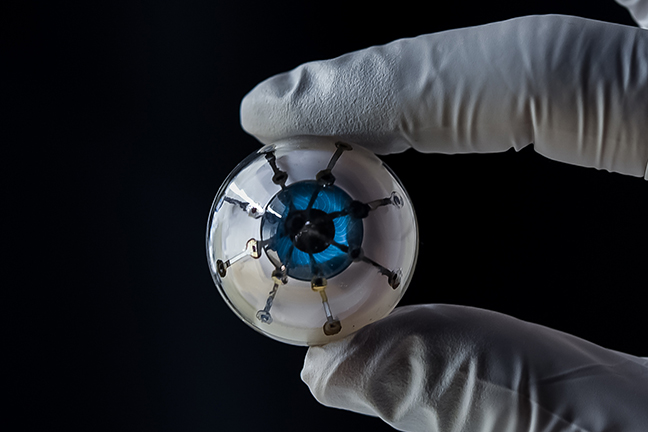University of Minnesota researchers have used a specialized 3-D printing technique to deposit a layer of photoreactive light receptors on the curved surface of what could be considered the first prototype of a bionic eye. In addition to being a significant step towards developing functional prosthetics which could effectively reverse blindness, this research also represents an advancement in 3-D printing technology and bioelectronics.
“Bionic eyes are usually thought of as science fiction, but now we are closer than ever using a multimaterial 3-D printer,” said Michael McAlpine, a co-author of the study and University of Minnesota Benjamin Mayhugh Associate Professor of Mechanical Engineering.
McAlpine and his team constructed their prototype bionic eye by printing a base of silver particles onto a hemispherical glass dome using a customized 3-D printer. One of the biggest challenges of 3-D printing on a non-flat service is that inks tend to run, but the researchers were able to demonstrate that their technique allowed for uniform drying of the applied inks.
Next, they printed light-converting photodiodes onto the silver-coated, curved surface using semiconducting polymer materials. These photodiodes can convert light into electrical signals which could be interpreted into images. In all, the 3-D printing process to create the bionic eye prototype took about 60 minutes, at which point the research team sought to determine the efficiency of the device.
Upon testing the 3-D printed eye, the researchers found it showed 25 percent efficiency at converting light signals into electricity – a promising number which could see this 3-D printing technique being used for broader microelectronic applications in the future.
“We have a long way to go to routinely print active electronics reliably, but our 3-D-printed semiconductors are now starting to show that they could potentially rival the efficiency of semiconducting devices fabricated in microfabrication facilities,” said McAlpine. “Plus, we can easily print a semiconducting device on a curved surface, and they can’t.”
McAlpine and his colleagues published the details of their bionic eye in the journal Advanced Materials.
The team has already patented their technology for 3-D printing semiconducting devices and hope to improve upon their prototype bionic eye in a few key areas. For one, adding more light receptors to the hemispheric surface would improve the efficiency of the device, potential giving individuals better vision. Another hurdle to overcome relates to the material on which the semiconductors are printed; currently, it’s a solid surface, however this technique would need to be adapted to a softer, more flexible material which would be more suitable for implantation into the eye.
McAlpine’s lab has also previously developed 3-D printed medical devices which incorporate electronics, including a bionic ear. Other applications of their 3-D printing technology include bionic skin and cell scaffolds designed for regenerative medicine.












Join or login to leave a comment
JOIN LOGIN